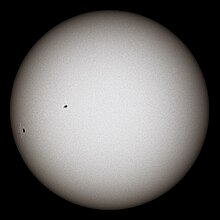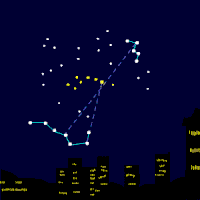
Back بوابة:نجوم Arabic Portail:Étoiles French Portal:Bintang ID Portale:Stelle Italian Portal:Estrelas Portuguese Portal:Stea Romanian Проект:Астрономические объекты/Звёзды Russian باب:ستارا Sindhi Portál:Hviezda Slovak Cổng thông tin:Sao Vietnamese
IntroductionA star is a luminous spheroid of plasma held together by self-gravity. The nearest star to Earth is the Sun. Many other stars are visible to the naked eye at night; their immense distances from Earth make them appear as fixed points of light. The most prominent stars have been categorised into constellations and asterisms, and many of the brightest stars have proper names. Astronomers have assembled star catalogues that identify the known stars and provide standardized stellar designations. The observable universe contains an estimated 1022 to 1024 stars. Only about 4,000 of these stars are visible to the naked eye—all within the Milky Way galaxy. A star's life begins with the gravitational collapse of a gaseous nebula of material largely comprising hydrogen, helium, and trace heavier elements. Its total mass mainly determines its evolution and eventual fate. A star shines for most of its active life due to the thermonuclear fusion of hydrogen into helium in its core. This process releases energy that traverses the star's interior and radiates into outer space. At the end of a star's lifetime as a fusor, its core becomes a stellar remnant: a white dwarf, a neutron star, or—if it is sufficiently massive—a black hole. Stellar nucleosynthesis in stars or their remnants creates almost all naturally occurring chemical elements heavier than lithium. Stellar mass loss or supernova explosions return chemically enriched material to the interstellar medium. These elements are then recycled into new stars. Astronomers can determine stellar properties—including mass, age, metallicity (chemical composition), variability, distance, and motion through space—by carrying out observations of a star's apparent brightness, spectrum, and changes in its position in the sky over time. Stars can form orbital systems with other astronomical objects, as in planetary systems and star systems with two or more stars. When two such stars orbit closely, their gravitational interaction can significantly impact their evolution. Stars can form part of a much larger gravitationally bound structure, such as a star cluster or a galaxy. (Full article...) Selected star - Photo credit: NASA
Canopus (/kəˈnoʊpəs/; α Car, α Carinae, Alpha Carinae) is the brightest star in the southern constellation of Carina, and the second brightest star in the night-time sky, after Sirius. Canopus's visual magnitude is −0.72, and it has an absolute magnitude of −5.65. Canopus is a supergiant of spectral type F. Canopus is essentially white when seen with the naked eye (although F-type stars are sometimes listed as "yellowish-white"). It is located in the far southern sky, at a declination of −52° 42' (2000) and a right ascension of 06h24.0m. Its name comes from the mythological Canopus, who was a navigator for Menelaus, king of Sparta. Canopus is the most intrinsically bright star within approximately 700 light years, and it has been the brightest star in Earth's sky during three different epochs over the past four million years. Other stars appear brighter only during relatively temporary periods, during which they are passing the Solar System at a much closer distance than Canopus. About 90,000 years ago, Sirius moved close enough that it became brighter than Canopus, and that will remain the case for another 210,000 years. But in 480,000 years, Canopus will once again be the brightest, and will remain so for a period of about 510,000 years. Selected article - Photo credit: NASA
Stars of different mass and age have varying internal structures. Stellar structure models describe the internal structure of a star in detail and make detailed predictions about the luminosity, the color and the future evolution of the star. Different layers of the stars transport heat up and outwards in different ways, primarily convection and radiative transfer, but thermal conduction is important in white dwarfs. The internal structure of a main sequence star depends upon the mass of the star. In solar mass stars (0.3–1.5 solar masses), including the Sun, hydrogen-to-helium fusion occurs primarily via proton-proton chains, which do not establish a steep temperature gradient. Thus, radiation dominates in the inner portion of solar mass stars. The outer portion of solar mass stars is cool enough that hydrogen is neutral and thus opaque to ultraviolet photons, so convection dominates. Therefore, solar mass stars have radiative cores with convective envelopes in the outer portion of the star. In massive stars (greater than about 1.5 solar masses), the core temperature is above about 1.8×107 K, so hydrogen-to-helium fusion occurs primarily via the CNO cycle. In the CNO cycle, the energy generation rate scales as the temperature to the 17th power, whereas the rate scales as the temperature to the 4th power in the proton-proton chains. Due to the strong temperature sensitivity of the CNO cycle, the temperature gradient in the inner portion of the star is steep enough to make the core convective. The simplest commonly used model of stellar structure is the spherically symmetric quasi-static model, which assumes that a star is in a steady state and that it is spherically symmetric. It contains four basic first-order differential equations: two represent how matter and pressure vary with radius; two represent how temperature and luminosity vary with radius. Selected image - Photo credit: NASA/TRACE
In astronomy, stellar classification is a classification of stars based on their spectral characteristics. The spectral class of a star is a designated class of a star describing the ionization of its chromosphere, what atomic excitations are most prominent in the light, giving an objective measure of the temperature in this chromosphere. Did you know?
SubcategoriesTo display all subcategories click on the ►
Selected biography - Photo credit: NASA
Stephen William Hawking (8 January 1942 – 14 March 2018) was an English theoretical physicist, cosmologist, and author who was director of research at the Centre for Theoretical Cosmology at the University of Cambridge. Between 1979 and 2009, he was the Lucasian Professor of Mathematics at Cambridge, widely viewed as one of the most prestigious academic posts in the world. Hawking was born in Oxford into a family of physicians. In October 1959, at the age of 17, he began his university education at University College, Oxford, where he received a first-class BA degree in physics. In October 1962, he began his graduate work at Trinity Hall, Cambridge, where, in March 1966, he obtained his PhD degree in applied mathematics and theoretical physics, specialising in general relativity and cosmology. In 1963, at age 21, Hawking was diagnosed with an early-onset slow-progressing form of motor neurone disease that gradually, over decades, paralysed him. After the loss of his speech, he communicated through a speech-generating device, initially through use of a handheld switch, and eventually by using a single cheek muscle. Hawking's scientific works included a collaboration with Roger Penrose on gravitational singularity theorems in the framework of general relativity, and the theoretical prediction that black holes emit radiation, often called Hawking radiation. Initially, Hawking radiation was controversial. By the late 1970s, and following the publication of further research, the discovery was widely accepted as a major breakthrough in theoretical physics. Hawking was the first to set out a theory of cosmology explained by a union of the general theory of relativity and quantum mechanics. Hawking was a vigorous supporter of the many-worlds interpretation of quantum mechanics. He also introduced the notion of a micro black hole. Hawking achieved commercial success with several works of popular science in which he discussed his theories and cosmology in general. His book A Brief History of Time appeared on the Sunday Times bestseller list for a record-breaking 237 weeks. Hawking was a Fellow of the Royal Society, a lifetime member of the Pontifical Academy of Sciences, and a recipient of the Presidential Medal of Freedom, the highest civilian award in the United States. In 2002, Hawking was ranked number 25 in the BBC's poll of the 100 Greatest Britons. He died in 2018 at the age of 76, having lived more than 50 years following his diagnosis of motor neurone disease. (Full article...) TopicsThings to do
Related portalsAssociated WikimediaThe following Wikimedia Foundation sister projects provide more on this subject:
Discover Wikipedia using portals |
























